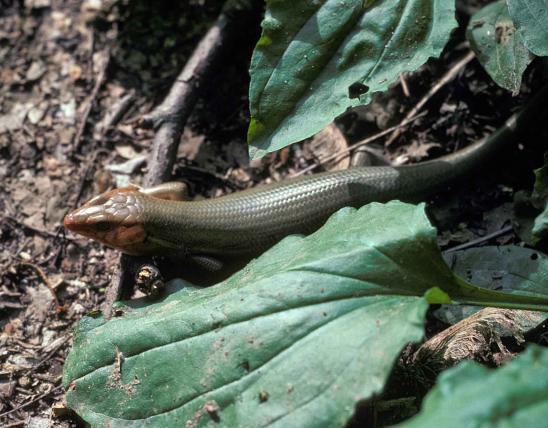
The prairie racerunner is a long, slender, fast-moving lizard of dry, open areas. The ground color is dark brown or black. There are normally 7 pale stripes that extend from the head along the back and sides onto the tail; these stripes may be yellow, white, gray, or pale blue. The tail is long, gray or brown, with slightly spiny scales that are rough to the touch. The head and front part of the body are tinged with blue or green, especially in males. The belly is gray or bluish gray in males and salmon pink to creamy white in females. Racerunners can run across an open area at what seems like lightning speed.
Missouri has two subspecies of the six-lined racerunner (Aspidoscelis sexlineata):
- The prairie racerunner (Aspidoscelis sexlineata viridis), described above, occurs statewide except for northern and north-central counties; it has 7 stripes instead of 6 and a wash of bright green over the head and front part of the body.
- The eastern six-lined racerunner (Aspidoscelis sexlineata sexlineata) mostly occurs to the east of Missouri, but its range apparently overlaps into southeastern Missouri, and it apparently intergrades with the prairie racerunner in that region; it has 6 stripes instead of 7.
- More study is needed to understand the Missouri distributions and degree of intergrading between these two subspecies.
Similar species: The Italian wall lizard (Pocarcis siculus) is a nonnative species with an introduced population in downtown Joplin (Jasper County). So far, this population is restricted to an urban area that supports few native lizards, but nearby natural habitat (rocky glades) must be monitored to ensure this invasive lizard does not become established and compete with our native lizards. The Italian wall lizard is native to southern Europe and the Mediterranean coast. It is in a different family than all of Missouri's lizards, but it looks something like a racerunner. It is generally a brown or gray lizard that usually has a green back. Patterns along the back and sides are highly variable, often with spots, stripes, or netlike patterns. The tail is mainly brown or gray. The belly has 6 rows of smooth scales that are usually white or cream. The total length can reach nearly 10 inches.
Adult total length: 6 to 10½ inches.

The prairie racerunner subspecies occurs throughout most of the southern half of Missouri and along the Mississippi and Missouri rivers in northern Missouri. The eastern six-lined racerunner subspecies apparently co-occurs and intergrades with the prairie subspecies in southeastern Missouri.
Habitat and Conservation
Racerunners live in open areas with loose soil or sand and sparse vegetation, especially in fields, grasslands, along river floodplains, and rocky, south-facing hillsides throughout the state. They can be quite abundant in open, rocky, south-facing hillsides, such as glades, in the Ozarks. They are also encountered along the edge of sand and gravel roads, railroad tracks, and abandoned rock quarries.
From mid-April to mid-September, these fast, alert lizards are normally active on warm, sunny days until midafternoon. On cool or cloudy days, and at times of extreme heat, they remain in burrows underground or beneath sheltering objects.
Their tails break off when grasped by a predator, allowing the lizard to escape. They do not hesitate to enter creeks or pools of water to escape.
In winter, these lizards escape harsh weather by burrowing into loose soil on south- or southwest-facing slopes.
Food
Racerunners eat insects, spiders, scorpions, and other invertebrates. Grasshoppers, crickets, leafhoppers, and jumping spiders can be favorite foods.
Status
In some locations, such as certain glade and open woodland habitats in the Ozarks, prairie racerunners can be the most abundant species of reptile.
Maintaining the open nature of rocky glades throughout the Ozarks will help keep racerunners common in Missouri.
Life Cycle
Courtship and mating occur from late April to June. Females age 2 or older normally lay 2 clutches per season. A clutch comprises 1–8 eggs; the female deposits them in a burrow she has dug in loose soil. Unlike Missouri’s skink species, racerunners do not remain with their eggs. Hatching usually occurs within 2 months (in August and September). The young grow quickly and can reach maturity in 1 to 2 years. Lifespan may be about 4 or 5 years.
Human Connections
As the only representative of the whiptail family in Missouri, these lizards bring a little taste of the West and the desert Southwest to our state. If you've traveled to the Southwest, there's a good chance you've seen the western whiptail, for example. Ozark glades, one of the preferred habitats of the prairie racerunner, are like miniature rocky deserts, a delight to hikers and part of our rich natural heritage.
Ecosystem Connections
Predators of this lizard include other lizards, such as eastern collared lizards (when they share the same habitat), snakes, birds, such as shrikes and roadrunners, and mammals, including skunks, badgers, and armadillos.
Missouri's racerunners represent only one species, including two subspecies, in family Teiidae, a group comprising the racerunners, whiptails, and other relatives. This family of lizards contains 146 species in 10 genera. The family is restricted to the Western Hemisphere and includes species in a surprising variety of sizes and forms. The smallest species is only 3 to 4 inches long, and the largest — the caiman lizard of South America — can reach 4 feet in length. Several West Indian teiids have been introduced into Florida. The majority of species range throughout Central America and the northern half of South America. Only one genus, Aspidoscelis (formerly Cnemidophorus), is native to the United States; it contains species commonly called racerunners and whiptails. These are medium-sized lizards with strong hind limbs and long, thin tails. There are about 10 species of Aspidoscelis lizards native to the United States; the majority reside in western states.

































